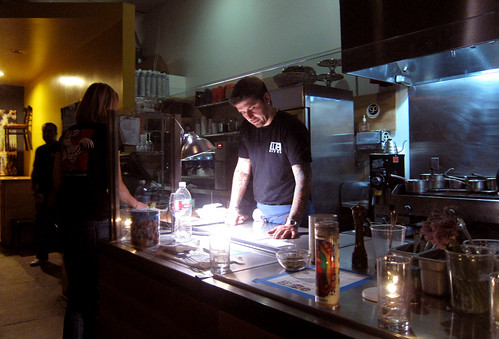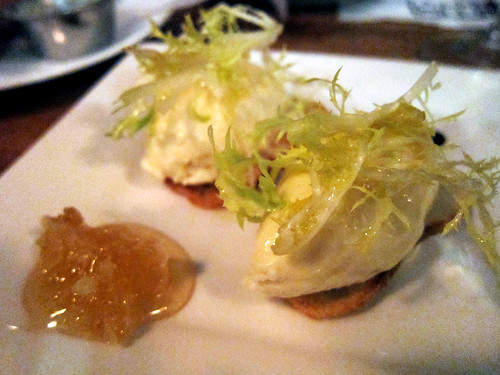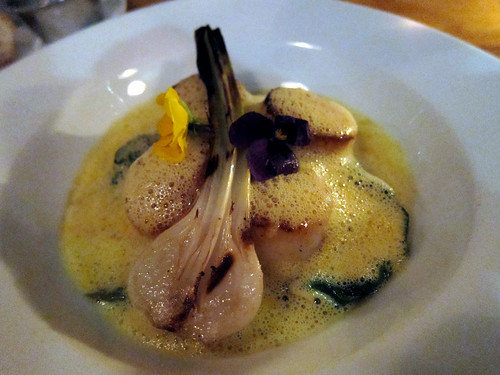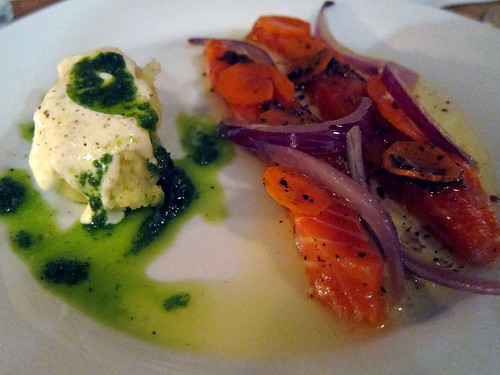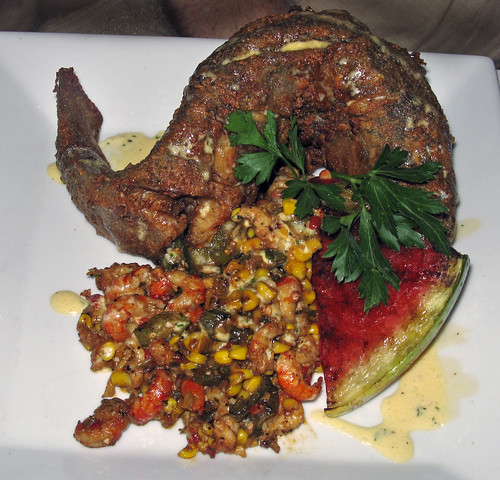The CSOWG‘s Thursday Drink Night (hosted in that wretched hive of scum and villainy delightful online chat room called The Mixoloseum Bar) on May 27, 2010 featured a sponsored product that may have escaped your attention — Mandarine Napoléon.
According to its producers, this French liqueur was originally created by Antoine-François de Fourcroy (1755-1809), Napoléon Bonaparte’s personal physician. Mandarines grew well on the isle of Corsica, the Emperor’s birthplace, and supposedly it was de Fourcroy who first macerated mandarine peels in strong alcohol, distilled the maceration and blended it with aged Cognac. The Emperor was so taken with the product that he often invited his physician to share a glass with him. Mandarine Napoléon was first bottled in 1892, and until very recently was still owned by the de Fourcroy family. De Kuyper, the Dutch producer of liqueurs and genevers, bought the product from the de Fourcroys about 9 months ago. However, according to a recent article in CLASS magazine, the Belgian distillery that’s produced the spirit base for the product since 1998 continues to do so, distilling the mandarine peels and botanicals, all of which is “sent to De Kuyper’s production facility for blending and bottling.”
The process is more or less the same as it’s always been– maceration of mandarine peels from Sicily and Spain in grain alcohol, distillation of the result, resting in vats for two years, sweetening and blending with various Cognacs with at least 6 years of age. The result is a deep, delicious liqueur at 77 proof, sweet but not cloying, and a strong mandarine flavor. It’s one of the best citrus liqueurs out there, and deserves some of the attention given to Grand Marnier and Cointreau.
Mandarine Napoléon’s public relations folks kindly sponsored a TDN and encouraged us to experiment, resulting in a number of really tasty cocktails. I, of course, lazy bastard that I am, decided to fall back on an existing cocktail of mine, because it so happened that I had already created a cocktail containing this liqueur. I had to stick with it, because it’s probably the best cocktail name I’ve ever come up with. (C’mon, a pun that doesn’t make you groan? That actually makes you laugh! Such a rarity!)
I hadn’t had one in a while, though I remember it being well-received by folks I had made it for at the time. Perhaps the most memorable fan is a friend of mine who might not be who you’d typically picture when you think of someone quaffing a cocktail made of Belgian liqueur and French apéritif wine — a country & Western bandleader, songwriter and guitar player (and a damned good one too). He came over with some friends one night, fell in love with this drink and quaffed them all evening long. Still, I thought it needed another look, just in case; I whipped one up to revisit and evaluate before submission.
Hmm.
Sure, still tasty. But it was sweet. Definitely sweeter than is our taste in cocktails these days (although perhaps not so much 10 years ago, when I came up with it.) Not quite balanced. Needed a little rejiggering.
Here’s the old post I wrote way back in September of 2000, talking about how I came up with the drink (and, as I recall, it’s the first cocktail I came up with on my own, albeit one that sprang from another):
Consider the Lillets…
(Stop groaning. It’s only going to get worse from here.)
Wes and I were browsing yesterday at a nifty antique shop and, naturally, stopped to peruse the barware section. They had a book on vintage barware, and in it was a recipe for a cocktail that sounded fascinating, and not only because I loved the name — the Tiger Lillet.
Lillet Blanc is, of course, the French aperitif white wine with hints of citrus and spice, and I’m quite fond of it. The recipe they printed didn’t quite add up, though — it called for 1/3 Lillet, 1/3 Van der Hum (a South African tangerine liqueur based on brandy) and 1/6 “Maraschino syrup”. Hmm. That’s only 5/6 of a drink. And what do they mean by Maraschino syrup? Do they mean Maraschino liqueur, or the thin sweet “juice” that the maraschino cherries come in? Was there a cocktail flavoring product back then that was a low- or no-alcohol cherry syrup? Despite this hole in the recipe, I thought the drink sounded very promising.
The web to the rescue! I found a site that had a more complete recipe which stated, as did the book, that the drink was the winner of the World Cocktail Championship in London in 1952, and was created by a barman named Mr. J. Jones (now that’s an unusual name). Here’s the actual recipe:
Tiger Lillet
1/3 Lillet.
1/3 Van der Hum.
1/6 Dry Vermouth.
1/6 Maraschino.
Shake and Strain. Serve with small piece of Orange Peel.
BZZZZZT! The dry vermouth just killed it for me. I do not like vermouth of any kind. I do not like it in a bar, I do not like it in a car. I do not like it in my drink; tastes quite nasty, that I think.
(Good gods … can you believe I actually said that. I used to hate vermouth. Well, in 2000 I was a toddler as far as fine and historic cocktails were concerned, and I think that at the time I was suffering from the same thing most people who think they hate vermouth suffer from — they’re drinking vermouth that has gotten old and gone bad. Ah, the things that change in ten years … in fact, fortunately for me, only a couple of years later I was quaffing vermouth-bearing cocktails with glee.) Now, back to the past:
So … how to go about changing this drink to suit my taste? Well, for starters, in all my digging through the two finest wine and spirits shops in Los Angeles, I’d never once seen Van der Hum liqueur. Fortunately, right there in my bar cabinet is a bottle of Mandarine Napoléon, another tangerine liqueur that’s based on brandy, which I thought would make an excellent substitute.
Another aside — it turned out that there is a “Maraschino syrup” product out there, the most widely-available of which is made by the Reese company, who’ve made some of the viler jarred products I’ve been unfortunately enough to buy in the supermarket. It’s artificially colored bright red, presumably a thicker version of the syrup in the horried neon red “maraschino” supermarket cherries — the use of which we’ve eschewed for years — and therefore vile. It’s pretty obvious that Mr. Jones used maraschino liqueur and not a syrup. Continuing with the old post:
We’re also fine for the maraschino — I love Liquore de Maraschino, and I have a bottle of Luxardo’s fine product right there in my bar.
Now, to replace the vermouth. For a 3-ounce drink, I’m really only substituting one tablespoon’s worth of liquor. I think the 1/3 Lillet content takes care of the aperitif wine flavor without adding more from vermouth, so I thought a bit about what might complement the flavor of both the Lillet and the Mandarine Napoléon. Cointreau and Grand Marnier were out, because I thought we had the citrus flavor covered. How ’bout … Cognac? Hmmmmm. Complimentary flavor, keeps it all French (“IT IS BELGIAN!” shrieks Poirot predictably, while sipping a cordial glass of Mandarine Napoléon) and gives it a slight extra kick. I like it. I liked it even better when I mixed one up and drank it last night.
Now, to name the drink. I can’t call it a Tiger Lillet anymore, since one ingredient has changed. That’s one of the cardinal laws of cooking — if you steal a recipe, you can get away with it by changing an ingredient or two, and then changing the name of the dish.
What’s Up, Tiger Lillet? I like Woody Allen, but that’s too close to the original. Calla Lillet? Kate Hepburn might like it, but I dunno… Gilded Lillet? Hrmm. Lillet Munster? Too silly! Lillet of the Valley? Lillet of the Field? Bleuchh. I really didn’t consider Consider The Lillet, either.
Finally, it struck me. I named the drink for someone I’ve really liked for a very long time and whose work has given me a great deal of enjoyment over the years. And that’s the truthhhhhh.
That old recipe called for an ounce each of Lillet and Mandarine Napoléon, and half-ounce each of Cognac and maraschino.
Okay. On the right track. But tooooo sweet.
A little thought, a little rebalancing. We still want to keep the Lillet as a base, but we want to up the Cognac to give it more backbone. Mandarine Napoléon is good, but a whole ounce of it was too much and lets a candylike sweetness creep forward. Back that off by a half an ounce, and back off the maraschino too. That should be there to help the fruit and Cognac flavors blend and round out, not to add any more sweetness. I decided to switch to the drier Croatian Maraska brand rather than the more powerful (and sweeter) Italian brand Luxardo. Finally, a dash of bitters for spice, edge and brightness.
Y’know, the flavor profile is pretty much the same, but this is a far superior drink, in my overly cocky– er, humble opinion. Consider the Lillet … reformulated.
LILLET TOMLIN
1-1/2 ounces Cognac.
1 ounce Lillet.
1/2 ounce Mandarine Napoléon.
1/4 ounce Maraska maraschino liqueur.
1-2 dash(es) Regans’ Orange Bitters No. 6.
Shake with cracked ice and strain into a chilled cocktail glass.
Garnish with a strip of orange peel, expressed over the glass and rubbed upon the rim. Garnish additionally with two ringy-dingys and serve to the party to whom you are speaking.

